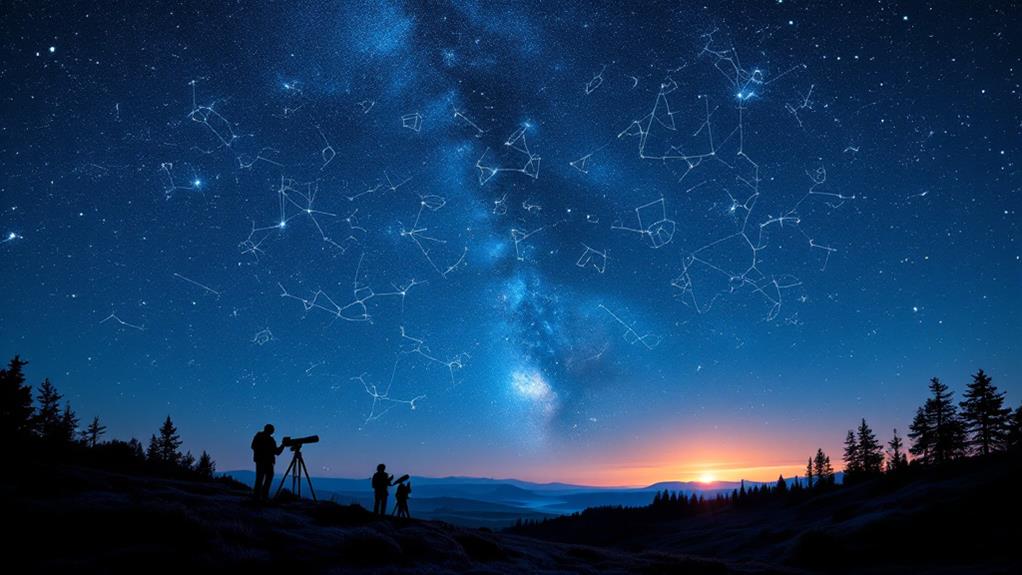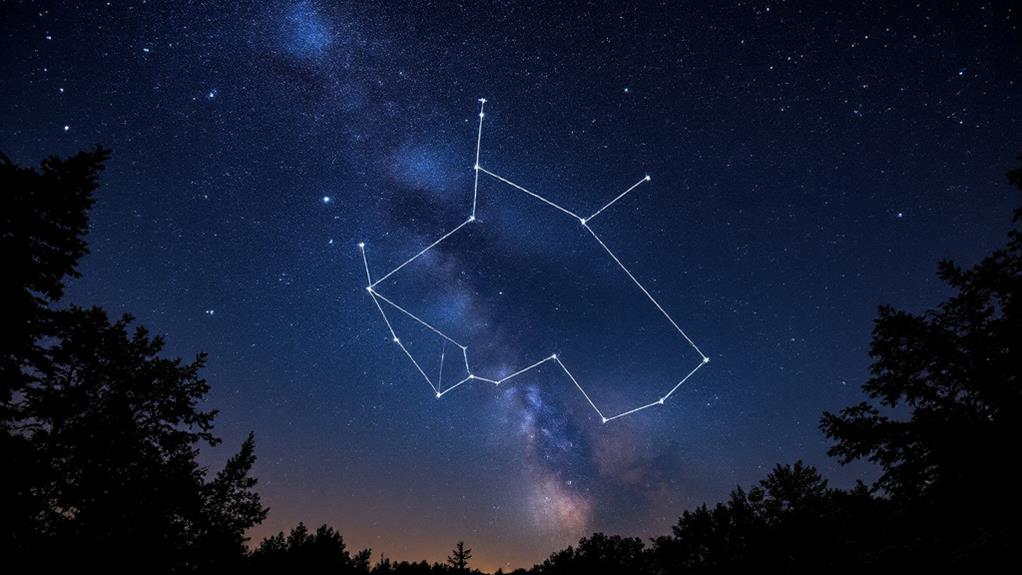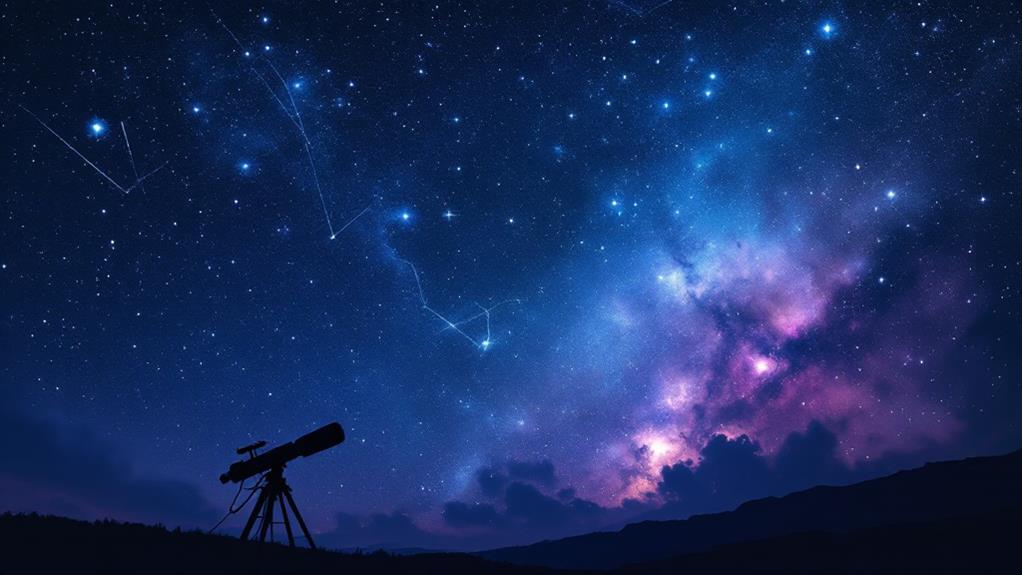How Large Is the Constellation Ursa Major?
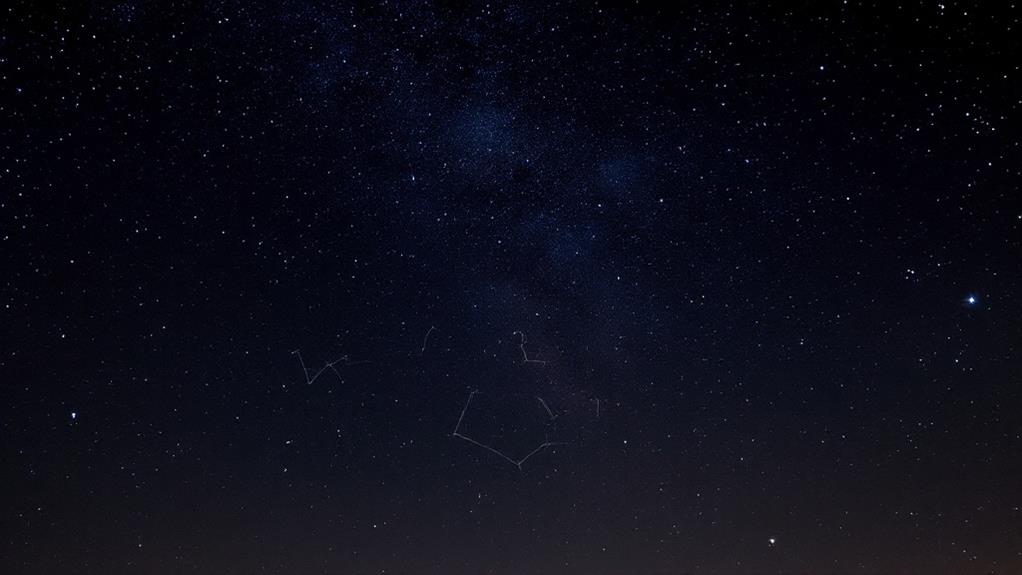
Ursa Major is a massive constellation, covering an impressive 1,280 square degrees of the celestial sphere. It's the third-largest constellation overall, occupying 3.1% of the entire night sky. You'll find it's the largest constellation visible from mid-northern latitudes, dwarfing many of its neighboring star patterns. Ursa Major's vast expanse is due to the wide spread of its stars across celestial coordinates. Its size and prominence make it an excellent reference point for locating other celestial objects. If you're curious about the night sky, understanding Ursa Major's vastness is just the commencement of an astronomical expedition.
Measuring Celestial Objects
When it comes to measuring celestial objects, astronomers rely on a variety of techniques and tools. To gauge the size of constellations like Ursa Major, you'll need to understand these methods.
First, you'll encounter the process of identifying celestial coordinates. This system uses right ascension and declination to pinpoint an object's location in the sky, much like latitude and longitude on Earth. By mapping the coordinates of the stars that make up Ursa Major, you can determine its overall span across the celestial sphere.
Next, you'll find that cataloging stellar magnitudes plays an essential role. This involves measuring the brightness of stars, which helps astronomers estimate their distance and size. In Ursa Major, you'll notice a range of magnitudes, from the bright Alioth to fainter stars barely visible to the naked eye.
To accurately measure Ursa Major's size, you'll also need to take into account its apparent size versus its actual dimensions in space. The constellation's stars aren't physically connected but appear grouped from Earth's point of view. By combining coordinate data, magnitude information, and advanced astronomical calculations, you can determine Ursa Major's true scale in our night sky.
Ursa Major's Area in Degrees
Astronomers measure Ursa Major's expanse in square degrees on the celestial sphere. This constellation covers an impressive 1,280 square degrees, making it the third-largest constellation in the night sky. To put this into perspective, it occupies about 3.1% of the entire celestial sphere. Ursa Major's main body is made up of seven stars, including the second-magnitude star Alioth. Merak and Dubhe are the pointer stars in Ursa Major that point directly to the North Pole star, Polaris.
When you're observing Ursa Major, you'll notice it spans a significant portion of the northern sky. Its large area is due to the spread of its stars across celestial coordinates. The constellation's boundaries are defined by these coordinates, which astronomers use to map the sky precisely.
Ursa Major's size isn't just about its area; it's also about the brightness of its stars. The constellation contains several stars with low apparent magnitude numbers, meaning they appear bright to us on Earth. The most famous asterism within Ursa Major, the Big Dipper, is easily visible even in light-polluted areas due to its bright stars.
Understanding Ursa Major's area helps you appreciate its prominence in the night sky and its importance in celestial navigation throughout history.
Comparison to Other Constellations
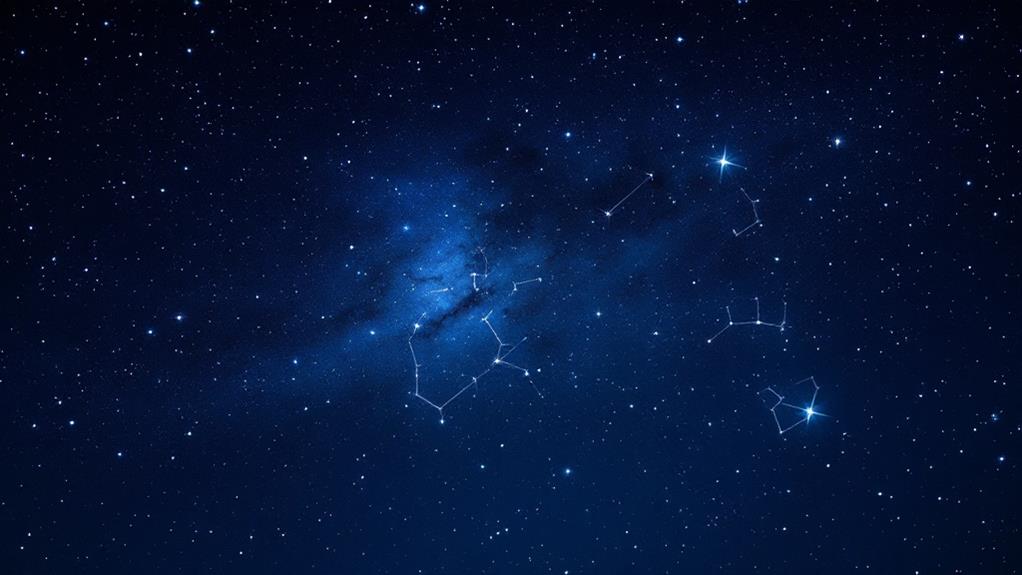
While Ursa Major is impressive in size, it's not the largest constellation in the sky. It ranks third in overall area, covering about 3.10% of the celestial sphere. You'll find that Hydra, the water snake, takes the top spot, followed by Virgo in second place.
When considering Ursa Major's relative size to the northern sky, you'll notice it's quite prominent. It's the largest constellation visible from mid-northern latitudes, making it a standout feature for observers in these regions. Its size and brightness contribute to its easy recognition, even for casual stargazers.
In comparison to neighboring constellations, Ursa Major eclipses many of its celestial companions. It's substantially larger than adjacent constellations like Canes Venatici, Leo Minor, and Lynx. However, it's comparable in size to some of its other neighbors, such as Draco and Boötes. When you observe Ursa Major, you'll see how it dominates its area of the sky, serving as a useful reference point for locating other celestial objects and constellations nearby.
Visibility Across the Globe
Ursa Major's distinctive shape graces the night sky for many observers around the world. This prominent constellation's visibility varies depending on your geographic location and the time of year. If you're in the Northern Hemisphere, you're in luck – Ursa Major is circumpolar for most northern latitudes, meaning it never sets below the horizon. You can spot it year-round, with its position changing in the sky as the Earth rotates.
For those living near the equator, Ursa Major's visibility is more limited. You'll only see it during certain seasons, typically appearing low on the northern horizon. In the Southern Hemisphere, the constellation becomes increasingly difficult to observe as you move further south. However, some of its brighter stars may still be visible from northern parts of Australia or South America during specific times of the year.
Seasonal visibility plays a significant role in observing Ursa Major. In spring, you'll find it high in the northern sky during evening hours. Summer brings it lower to the northwest, while autumn sees it sinking towards the northern horizon. Winter offers prime viewing opportunities, with the constellation rising in the northeast.
Key Stars and Their Distances
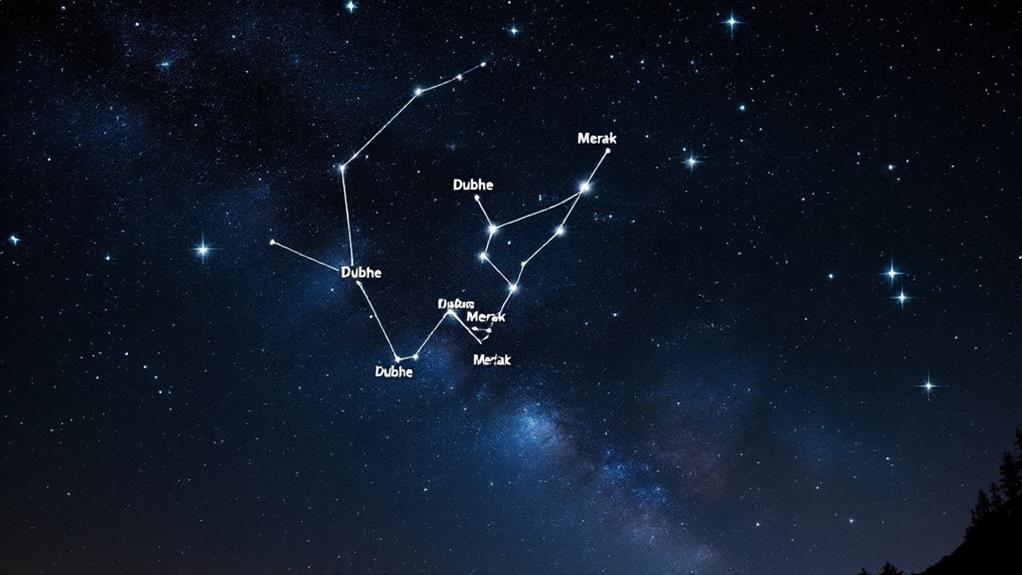
For centuries, stargazers have marveled at the bright stars that make up Ursa Major. This constellation boasts several key stars that contribute to its distinctive shape and visibility. The most prominent stars in Ursa Major are the seven that form the Big Dipper asterism: Dubhe, Merak, Phecda, Megrez, Alioth, Mizar, and Alkaid. The Big Dipper is the most prominent part of this Ursa Major constellation, covering 3.10% of the sky and making it hard to miss.
These stars vary greatly in their distances from Earth. Dubhe, the brightest star in the constellation, is approximately 123 light-years away, while Merak is about 79 light-years distant. The farthest of the Big Dipper stars is Alkaid, located roughly 101 light-years from us. The prominent stars' luminosity plays a crucial role in their visibility despite these vast distances.
It's important to note that stellar motion within the constellation affects its appearance over time. While the Big Dipper's shape remains recognizable for thousands of years, the stars are moving at different speeds and directions. This gradual movement will eventually alter the constellation's familiar pattern, though not noticeably in our lifetimes. Understanding these key stars and their distances helps you appreciate the vast scale and dynamic nature of Ursa Major.
Ancient Myths and Cultural Significance
Numerous ancient cultures have woven rich mythologies around Ursa Major, attributing weighty significance to this celestial formation. You'll find its mythological origins deeply rooted in Greek legend, where Zeus plunged Callisto and her son Arcas into bears, placing them in the sky as Ursa Major and Ursa Minor. In Native American folklore, you'll uncover the constellation often represents a great bear pursued by hunters.
The cultural symbolism of Ursa Major extends far beyond these tales. In Hindu mythology, you'll see it associated with the Seven Sages, while ancient Britons viewed it as King Arthur's chariot. For many cultures, you'll find Ursa Major served as a celestial compass, with the Big Dipper's pointer stars indicating the North Star.
You'll notice that Arab astronomers saw a different pattern in these stars, imagining a coffin followed by mourners. In China, you'll learn that Ursa Major was known as the Northern Dipper, playing a pivotal role in Taoist cosmology. These diverse interpretations highlight how Ursa Major has captivated human imagination across civilizations, shaping our understanding of the night sky.
Observing Ursa Major's Vastness
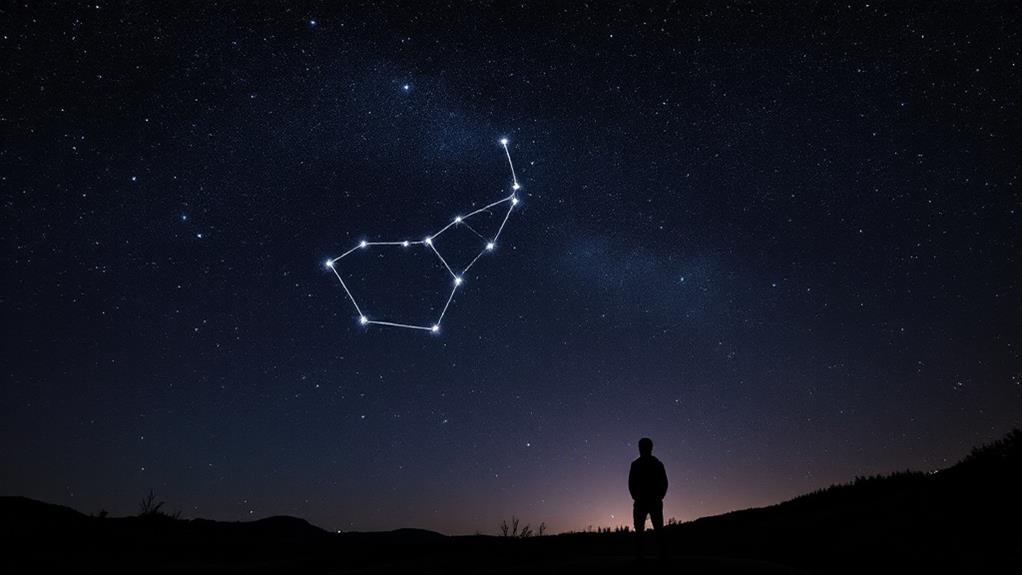
When you turn your gaze to the night sky, you'll be struck by the sheer magnitude of Ursa Major. This expansive constellation spans an impressive 1,280 square degrees, making it the third-largest of the 88 modern constellations. To put its size into perspective, Ursa Major covers about 3% of the entire celestial sphere.
You'll find that observing Ursa Major's vastness requires patience and careful nocturnal observations. The constellation's visibility changes with seasonal variations, but it remains circumpolar for most Northern Hemisphere observers. This means you can spot it throughout the year, rotating around the celestial pole. During spring evenings, you'll see Ursa Major high overhead, while in autumn, it appears lower in the northern sky.
To fully appreciate its scale, you'll need to look beyond the familiar Big Dipper asterism. The constellation's boundaries extend far beyond these seven bright stars, encompassing numerous fainter stars and deep-sky objects. With a pair of binoculars or a small telescope, you can investigate the constellation's rich star fields and uncover hidden celestial treasures within its vast expanse.
Scientific Importance of Large Constellations
Large constellations like Ursa Major play an indispensable role in astronomical research and orientation. These vast star patterns serve as crucial reference points for celestial cartography, helping astronomers and navigators alike to locate and map other celestial objects. You'll find that large constellations are especially precious in sky mapping, as they provide easily recognizable anchors in the night sky.
When you're studying the cosmos, you'll appreciate how these expansive constellations offer a wide field of view for observing various phenomena. They often contain a diverse array of stars, nebulae, and galaxies, making them prime targets for both amateur and professional astronomers. Additionally, large constellations like Ursa Major are excellent for tracking celestial motion and studying proper star movement over time.
These expansive star patterns also play a significant role in education and public outreach. Their size and visibility make them ideal for introducing novice stargazers to the night sky, cultivating interest in astronomy, and helping people understand the vastness of our universe. By serving as cosmic landmarks, large constellations continue to bridge the gap between scientific research and public engagement in astronomy.
Frequently Asked Questions
How Many Stars Are Visible to the Naked Eye in Ursa Major?
You'll typically see about 7 to 8 bright stars in Ursa Major with your naked eye, forming the iconic Big Dipper pattern. However, star count fluctuations can occur due to varying atmospheric conditions and light pollution. Your visibility may change depending on your latitude, with northern observers generally having a better view. If you're in a dark location, you might spot up to 20 fainter stars within the constellation's boundaries, enhancing your stargazing experience.
What Is the Brightest Star in Ursa Major Called?
You might be surprised to learn that Arcturus isn't actually the brightest star in Ursa Major, despite its dazzling appearance. It's a common misconception because Arcturus is so prominent in the night sky. In fact, the brightest star in Ursa Major is called Alioth. Alkaid, the second brightest star in Ursa Major, is another notable celestial body in this constellation. Both of these stars outshine their companions, making them key features to look for when observing the Great Bear.
Are There Any Exoplanets Discovered in the Ursa Major Constellation?
You'll be excited to know that astronomers have unearthed several exoplanets in the Ursa Major constellation. These celestial bodies within Ursa Major offer fascinating perspectives into planetary systems beyond our own. You can plunge into the diversity of these alien worlds, ranging from gas giants to potentially habitable super-Earths. As technology advances, you're likely to hear about even more exoplanets being found in this constellation, broadening our understanding of the universe and its countless possibilities.
How Fast Is Ursa Major Moving Through Space?
You'll find that Ursa Major's motion through space is quite fascinating. The constellation's stars have varying relative velocities, with some moving faster than others. On average, you'd observe a space motion of about 80 kilometers per second for many of its stars. However, it's important to observe that this isn't uniform across the entire constellation. Some stars within Ursa Major are actually moving in different directions, giving the constellation a changeable nature over long periods.
Can Ursa Major Be Seen From the Southern Hemisphere?
You can't see Ursa Major from most of the southern hemisphere. It's a circumpolar constellation for northern observers, meaning it's visible year-round. However, if you're in the far northern parts of the southern hemisphere, you might catch a glimpse of it low on the horizon during certain seasons. The constellation's visibility depends on your exact latitude, with more southern locations having less chance of seeing it at all.

